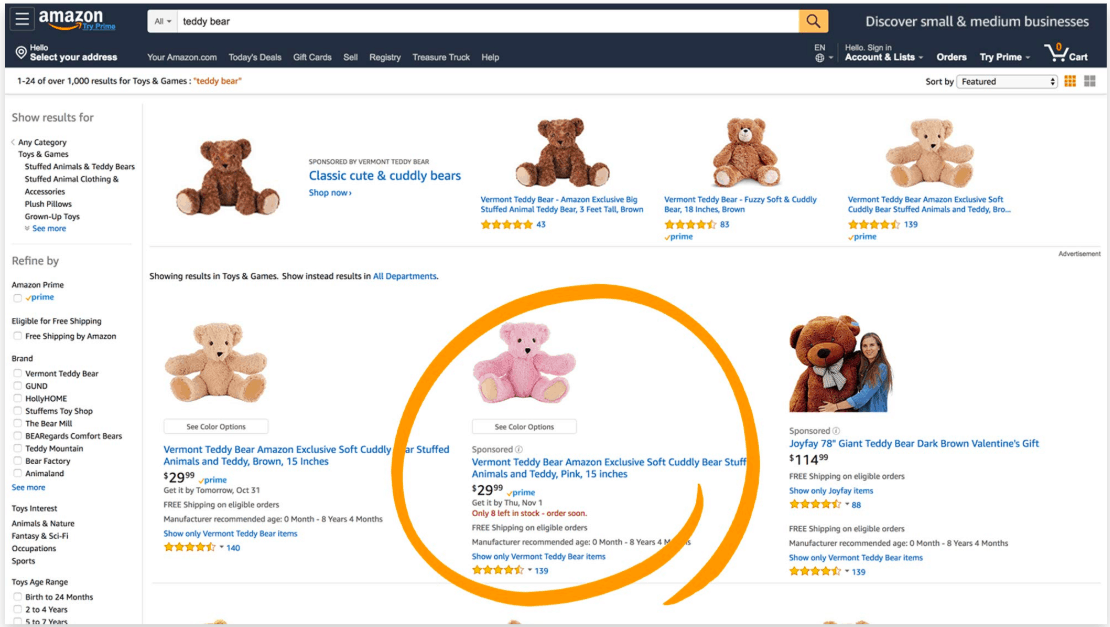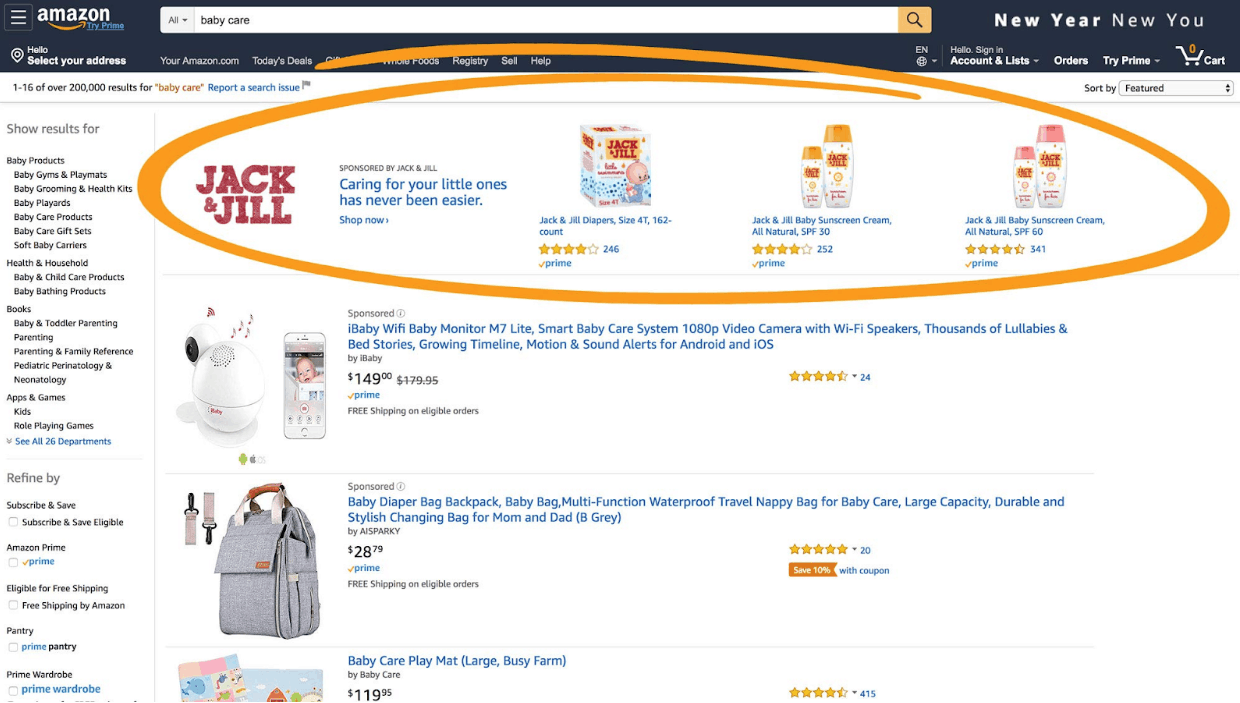What Is Amazon Advertising?
Amazon advertising is based on the pay-per-click (PPC) model, meaning your business will not be charged for an ad until a customer clicks on it. To buy an ad, Amazon relies on the auction method: businesses name the price they’re willing to pay for a click, and those that win the “auction” have their ads appear.
7 Best Practices For Optimizing Your Amazon Ads Strategy
Winning on Amazon isn’t easy! It has different rules than any other ad channel — online or offline. But Amazon Ads presents a unique opportunity if you can take full advantage of it. Here are seven Amazon advertising strategies you can implement to see better ROI on your Amazon marketing campaigns:
Here are seven Amazon advertising strategies you can implement to see better ROI on your Amazon marketing campaigns:
- Master Sponsored Products
- Master Sponsored Brands
- Including keywords in product listings
- Ensure product listing descriptions are accurate and robust
- Use high-quality images
- Garner positive reviews
- Use an ad management tool to manage your campaigns

Amazon advertising strategies 101: Master the paid ads
The first step to creating a killer Amazon advertising strategy is understanding exactly what constitutes an Amazon ad. Amazon sells ads based on the pay-per-click (PPC) model, meaning your business will not be charged for an ad until a customer clicks on it. To buy an ad, Amazon relies on the auction method: businesses name the price they’re willing to pay for a click, and those that win the “auction” have their ads appear.
The two main types of Amazon ads are Sponsored Products and Sponsored Brands.
Sponsored Products: Amazon’s Sponsored Products show up in search results as well as alongside organic search results on product detail pages. These ads appear based on keywords, and businesses can choose which keywords prompt their ads or allow Amazon to suggest search terms to target the ad.

An example of Sponsored Products
Sponsored Brands: Sponsored Brands are keyword-targeted ads that feature the brand’s logo, a custom headline, and up to three product listings. These ads appear within search results and generally at the top of the page.

An example of Sponsored Brands
Amazon advertising strategies 101: Understand organic search optimization (SEO)
But understanding how to advertise on Amazon is about much more than simply purchasing ads. While Amazon’s search ads might mean that businesses see a boost in sales immediately, search engine optimization (SEO) has important long-term effects, moving products to the top of search results (and keeping them there) over time. On a regular search engine such as Google, SEO is about getting pages to rank at the top — on Amazon, SEO is about getting product listings to the top.
While optimizing for Amazon search, creating excellent product listings — whether for paid ads or organic search results — is critical any successful Amazon advertising strategy.
Keywords Count
When creating a product listing that will appeal to both buyers and A9 (Amazon’s search algorithm), keywords in the product title are critical. Try to include as many keywords as possible without sacrificing clarity. So, for example, instead of calling a product a “Backyard Planter,” try something like “Delectable Garden Cloth 12 Pocket Hanging Vertical Garden Wall Planter for Yard Garden Home Decoration” (an actual top result that pops up when searching for “backyard planter” on Amazon.
The bullet points that list additional product information are also valuable to help customers compare products and to help A9 yield accurate results. Try to avoid repeating any of the keywords from the title in these descriptions, as repetition doesn’t seem to affect search ranking, and customers will be looking to these bullet points to try and differentiate one product from another. Use the bullets to pitch your product’s utility in keyword-rich language.
Make sure the text stands out
As much as most of us would like to believe that grammar and spelling lessons belong purely to school days, well-written, typo-free copy means a great deal when it comes to an Amazon advertising strategy. Customers are pretty wary of Amazon scams, and many take poor grammar, unclear product descriptions, and misspelled words as a sign that a product might not be on the up and up.
All words used in titles and product descriptions should be informative and focused on the product’s benefits. Why might the searcher want the 12-pocket hanging wall planter over other similar planters? Make sure your descriptions are not only accurate and easy to read but also sell your item.
Picture Perfect
For online shopping, customers are always worried about the hassle of returning a not-quite-right product through the mail, and images can make or break a sale. So, it is crucial that retailers pay close attention to the visual element of Amazon advertising campaigns.
First, ensure all pictures of your products follow Amazon’s guidelines, which call for high-quality images of at least 1,000 pixels or larger. Keeping your images focused on the product being sold is also important. And be sure the image listed on Amazon accurately represents what the product looks like in real life.

Reviews Matter
But even if your copy is excellent, images high quality and realistic, and your stellar Amazon advertising strategy has paid off in the form of clicks and (hopefully) sales, you’re not quite done. Customer reviews also matter a great deal. Because even if you’ve invested heavily in Amazon search advertising, it’s a good idea to always have one eye on your business’s organic search results as well. And on Amazon, an abundance of good reviews is a great way to get to the top of SERPs.
However, because fraudulent sellers often try to game the system by posting thousands of reviews clearly written by bots, most Amazon shoppers have gotten rightfully suspicious when there are too many glowing, yet awkwardly written reviews.
To combat fake reviews, Amazon has pretty strict rules around what sellers can and can’t do to solicit customer feedback, but there are absolutely ways to ethically make getting good reviews for excellent service a part of your Amazon advertising strategy. Send follow-up emails after a sale or include package inserts politely asking for reviews. Be careful not to come off as demanding a review or offering up a bribe. Instead, ask your customers nicely to leave a review if they are satisfied with their purchase.
Also, provide a way for dissatisfied customers to contact your business directly rather than leave a negative review. And as for those negative reviews that will inevitably pop up, make sure to respond and resolve the problem quickly, which shows other shoppers that your business cares about keeping customers happy.
Amazon advertising strategies 101: Have a great tool
As part of Skai’s omnichannel marketing platform, our Retail Media solution empowers brands to plan, execute, and measure digital campaigns that meet consumers when and where they shop. Built with best-in-class automation and optimization capabilities, our unified platform allows you to manage campaigns on 30+ retailers including Amazon, Walmart, Target, and Instacart all in one place.
Client results include:
- 461% increase in Amazon Ads ROAS and 57% increase in page traffic for Bondi Sands
- 92% increase in share of voice on Amazon for a Fortune 500 CPG brand
- 72% increase in revenue for VTech
- 1,390% year-over-year sales growth for Kamado Joe
To learn more, please schedule a quick demo with our insightful team.






